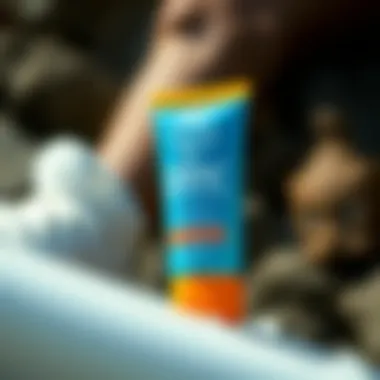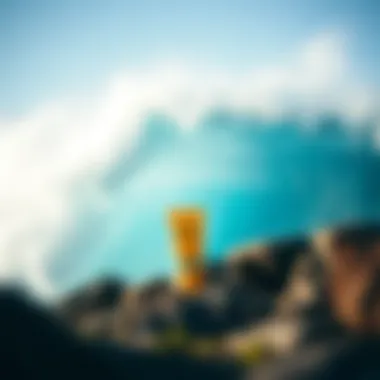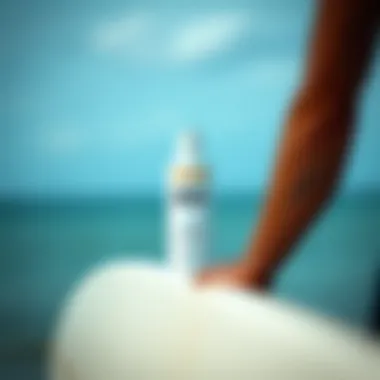Zinc Sunscreen: Essential Protection for Surfers


Intro
Every surfer worth their salt knows that hitting the waves means more than just catching the perfect swell. Among the array of gear that surfers lug to the beach, zinc sunscreen has risen to the forefront as an essential player in skin protection—a necessity that pairs well with surfboards and wetsuits. The sun beats down with unrelenting vigor when you're out on the water for hours, and the consequences of not protecting yourself can be more than just sunburn. From painful burns to the long-term risk of skin cancer, the stakes are high for those who paddle out day after day.
But zinc sunscreen isn't just about safeguarding your skin. It also reflects a commitment to keeping our oceans vibrant and clean. Many commercial sunscreens contain harmful chemicals that can negatively impact marine life. Zinc-based formulas, in contrast, offer a more eco-friendly alternative, which is crucial for those who love the ocean and want to preserve it. Understanding how to choose the right zinc sunscreen not only equips surfers with vital protection but also bestows them with knowledge to make informed purchases that benefit both themselves and the ecosystems.
In this article, we will dive deep into the multifaceted world of zinc sunscreen. We’ll unpack the protective benefits it brings, the varieties of formulations available, tips for effective selection and application, along with common misconceptions surrounding its use in the surfing community. Surfers, instructors, beach lifeguards, and even marine biologists will find the insights offered here valuable as they navigate the dual priorities of skin health and environmental stewardship. By focusing on education and empowerment, we aim to cultivate a culture where caring for oneself goes hand-in-hand with caring for the ocean.
Intro to Zinc Sunscreen
As surfers ride waves and chase sunsets, they often overlook a crucial element sharing the sands with them: sunscreen. More specifically, zinc sunscreen. This section aims to make clear why zinc sunscreen deserves a prime spot in every surfer's beach bag. Understanding this topic isn't just about skin health; it's about enhancing outdoor experiences in a safe and eco-friendly manner.
Understanding Sunscreen Basics
Sunscreen isn’t merely a gooey cream you slather on before hitting the surf; it’s a vital shield against harmful ultraviolet (UV) rays that can lead to skin damage, premature aging, and even skin cancer. Sunscreens primarily come in two categories: chemical and physical. Chemical sunscreens absorb UV rays through their chemical ingredients, while physical sunscreens, often containing active minerals like zinc oxide or titanium dioxide, provide a protective barrier that reflects those rays away from the skin. The importance of understanding these differences lies in selecting a product that not only protects but is also compatible with one's skin type and lifestyle.
Using sunscreen isn't optional for surfers. With long hours spent bobbing in ultraviolet rays, the risk of sunburn and long-term skin damage significantly increases. Surfers face the dual challenge of maintaining their skin health while also considering the impact of their choices on the delicate marine ecosystem. Because of these factors, many surfers are now turning to zinc sunscreen for its vast benefits.
What is Zinc Oxide?
Zinc oxide is an inorganic compound that serves as the active ingredient in many physical sunscreens, boasting a number of benefits that make it a front-runner for those who frequent the surf. At its essence, zinc oxide acts as a mineral sunscreen, creating a reflective barrier on the skin that effectively blocks both UVA and UVB rays. Unlike chemical sunscreens that can be harsh or irritating, zinc oxide is known for its gentle nature, making it suitable for all skin types, including sensitive or sunburn-prone skin.
In addition to its protective qualities, zinc oxide has skin-soothing properties, which can calm inflammation and reduce irritation. This characteristic becomes especially relevant for surfers, who may find themselves exposed to sun, saltwater, and wind – all of which can wreak havoc on their skin. By incorporating zinc oxide into their sunscreen routine, surfers can not only protect their skin from harmful rays but also promote healing and recovery.
In summary, both the fundamentals of sunscreen and the specific role of zinc oxide are vital concepts for surfers to grasp. They pave the way for smarter choices that combine effective protection with a lighter footprint on the environment, ensuring that surfing continues to be an enjoyable and safe activity.
Importance of Sunscreen in Surfing
When it comes to surfing, sunscreen isn't just an accessory—it's as essential as your board. Sun exposure isn’t just a byproduct of your time on the waves; it’s a real risk that can lead to skin damage and long-term health issues. Surfers spend hours exposed to the sun, and the reflection from water can amp up UV rays, making adequate protection crucial.
This introduction to the necessity of sunscreen for surfers goes beyond the surface, diving into the critical reasons why protection is essential. The construction of zinc-based formulas offers more than just a layer between your skin and the sun; it reduces the dangers you face every time you paddle out.
The Risks of UV Exposure
The sun emits two types of ultraviolet radiation harmful to the skin: UVA and UVB. While we often hear about sunburn related to UVB rays, the damage caused by UVA is more insidious, contributing to premature aging and increasing the risk of skin cancer. Surfers might think of tan lines and sunburns, but they should also be aware that prolonged UV exposure could lead to skin diseases.
- Sunburn: The most obvious and immediate effect, characterized by red, painful skin. This can spoil your day on the water.
- Skin Cancer: Possible with repeated exposure over time. Melanoma and other forms of skin cancer are serious health risks for those who don’t shield themselves adequately.
- Premature Aging: Wrinkles, leathery skin, and age spots can start showing up earlier than they should for unprotected surfers.
Skin Protection for Surfers
It’s not just about aesthetics; skin protection is as vital as having a solid surf performnce. Using a high-quality zinc sunscreen adds an important line of defense against the harsh elements of the elements.
A few points to consider:
- Application: Applying sunscreen generously and evenly is significant. It needs to cover every inch, especially the ears, nose, and behind the knees, areas often forgotten.
- Water Resistance: Surfers should look for sunscreens that are specifically labeled as water-resistant. This ensures that the protection lasts longer, particularly during lengthy surf sessions where you're frequently in and out of the water.
- Physical vs Chemical: Zinc sunscreens provide a physical barrier against UV rays by sitting on top of the skin, rather than absorbing into it like chemical sunscreens. This means that zinc-based products offer immediate protection upon application, which is crucial for surfers.
"Every time you step onto a wave, you're battling both the ocean and the sun's relentless rays. Protect yourself—your skin will thank you later."


In essence, understanding the necessity of sunscreen in surfing aids in making informed choices about skin health. The ocean can take its toll, but with proper protection, you can enjoy every wave while minimizing risks to your health.
Benefits of Using Zinc Sunscreen
When it comes to protecting our skin while catching waves, zinc sunscreen stands out for many reasons. For surfers, who routinely face intense sun exposure, the benefits of using zinc oxide-based sunscreen is paramount. This section will delve into several key advantages that emphasize why every surfer should make zinc sunscreen a part of their essential gear.
Broad Spectrum Protection
One of the primary benefits of zinc sunscreen is its broad spectrum protection capability. This term refers to the product's effectiveness against both UVA and UVB rays. UVA rays can penetrate the skin deeply, leading to premature aging and an increased risk of skin cancers, while UVB rays primarily affect the surface of the skin, causing sunburn. Zinc oxide provides a physical barrier that reflects and scatters these harmful rays, offering reliable protection.
Moreover, surfers often find themselves hours at a time under the relentless sun. In addition to the immediate benefits of preventing sunburn, consistent use of zinc sunscreen may reduce the cumulative long-term effects of skin damage. It’s this comprehensive coverage that makes zinc sunscreen a smart choice, particularly for those who love to surf early mornings or during the hot afternoon.
Gentle on the Skin
Surfers put their skin through a lot during a session—whether it's exposure to saltwater, sun, or the rough texture of a surfboard. A notable advantage of zinc sunscreen is that it is typically formulated with fewer chemical irritants compared to chemical sunscreens. Many chemical sunscreens contain compounds that may cause allergies or irritation, especially for sensitive skin types. Zinc oxide, on the other hand, tends to be well tolerated and is often recommended for individuals with skin conditions like eczema.
This gentle nature is essential for surfers, who often need to reapply sunscreen multiple times throughout the day. Choosing a product that is less likely to cause breakouts or irritation means a surfer can focus on riding waves rather than worrying about their skin. Plus, zinc’s anti-inflammatory properties can help soothe already irritated skin.
Environmentally Friendly Characteristics
Environmental consciousness has become increasingly relevant in today's surf culture. Conventional sunscreens often contain chemical agents, such as oxybenzone and octinoxate, which have been shown to cause significant harm to marine ecosystems, particularly coral reefs. Zinc sunscreen stands out here because environmental advocates highlight its reef-safe characteristics.
Many zinc-based formulations are also biodegradable, meaning they won't leave harmful residues in ocean waters. By choosing environmentally friendly products, surfers can not only protect their skin but also contribute to the health of our oceans.
"Opting for zinc sunscreen is not just a choice for personal health; it’s a way of showing care for the marine life that makes our favorite waves possible."
Choosing the Right Zinc Sunscreen
Selecting an appropriate zinc sunscreen is an essential step for surfers seeking to shield their skin from the relentless sun while enjoying the surf. By understanding key factors, you can make informed decisions that not only protect your skin but also consider the environmental impact of your choices. It goes beyond just picking up any bottle off the shelf; you want to ensure you have a product that fits not only your skin's needs but also your surfing lifestyle.
Key Ingredients to Look For
When navigating the crowded aisles of sunscreen products, it helps to know what ingredients are worth your attention. First and foremost, zinc oxide is crucial, as it provides broad-spectrum protection against both UVA and UVB rays. If the sunscreen also contains a moisturizing agent like aloe vera or vitamin E, it can be beneficial as these components add hydration, which can be particularly useful after long hours in the ocean.
Additionally, consider looking for formulations free from harmful additives. Parabens, fragrance, and artificial colors can cause skin irritation, especially when exposed to saltwater and sun. It’s vital to look for the term "non-nano" when reading labels, as this indicates that the zinc particles are larger and less likely to be absorbed into the skin, providing a physical barrier.
"Choosing the right sunscreen isn’t just about skin health; it’s about making a choice that respects our ocean ecosystems."
SPF Ratings Explained
Understanding SPF, or Sun Protection Factor, is not as straightforward as many believe. An SPF rating describes how much longer you can stay in the sun without burning compared to without protection. For instance, an SPF of 30 theoretically allows someone to be exposed to sunlight 30 times longer than they could without any sunscreen. However, this does not mean that higher is always better. A sunscreen with SPF 50 might block merely 1% more UV rays than one with SPF 30. Ultimately, surfers should look for a product with at least SPF 30 for reliable protection, alongside frequent reapplication. Just because the number is high doesn't mean one can slack off on application.
Water Resistance Factors
Water resistance is a game-changer for surfers who spend a significant amount of time in the water. Sunscreens are usually labeled as water-resistant for either 40 or 80 minutes. This indicates how long the product maintains its effectiveness while swimming or sweating. When choosing a sunscreen, go for one that offers at least 80 minutes of water resistance; this gives peace of mind during those intense sessions where you spend more time in the waves than out.
Also, remember that no sunscreen is fully waterproof. Reapplication is still key after surf sessions or if you towel off. A little diligence ensures you remain protected without compromising the health of your skin.


By carefully considering these factors in choosing a zinc sunscreen, surfers can ensure they’re well-prepared to protect themselves from the sun while respecting the environment. Knowing what to look for not only empowers you but can make all the difference in how you enjoy your time on the waves.
Application Techniques for Effective Protection
When it comes to enjoying the waves, applying zinc sunscreen correctly is more than just a trivial task—it's a critical step to protect both our skin and the oceanic environment we love so much. This section discusses various techniques for effective application, which directly impact the efficacy of zinc sunscreen, ensuring surfers can ride those waves without worrying about harmful UV exposure.
Best Practices for Application
Applying zinc sunscreen is an art in itself, and there are several best practices to keep in mind for maximum protection. Here are some pointers to help ensure that every inch of your skin is shielded:
- Start with Clean Skin: Ensure that your skin is clean and dry before application. If you’re just coming out of the water, rinse off salt and sand first.
- Apply Generously: Don’t skimp on the amount of sunscreen. Ideally, you should use about a nickel-sized amount for your face and an ounce for your body. Cover all exposed areas, including often-overlooked spots like the tops of your feet, behind your ears, and your scalp if you have thinning hair.
- Use the Right Technique: Rub the sunscreen into your skin thoroughly—no need to rush. The more evenly spread and rubbed it is, the better it adheres to your skin.
- Timing Matters: Apply sunscreen at least 15 to 30 minutes before heading out into the sun. This allows it to soak into your skin and offer the protection needed.
With these straightforward habits, applying zinc sunscreen can become a seamless part of your surfing routine.
Reapplication Guidelines
For surfers, the sun's rays can be relentless, and staying protected means adhering to reapplication guidelines effectively. Here’s what you should consider:
- Frequency is Key: Reapply every two hours, or immediately after swimming or sweating. Water-resistant formulas may last longer but are not bulletproof.
- Monitor Your Environment: If you’re surfing on particularly sunny days or in high-reflection environments like the ocean, consider reapplying more frequently.
- Follow the Product Instructions: Different brands have different formulations, and it is essential to check their specific instructions for reapplication.
By staying vigilant with reapplication, you significantly increase your defense against UV damage.
Common Application Mistakes to Avoid
Even seasoned surfers can fall into the traps of improper sunscreen application. Here are some pitfalls to steer clear of:
- Ignoring Labels: Not all sunscreens are created equal. Failing to select a broad-spectrum formula with adequate SPF—30 or above—can lead to unexpected sunburns.
- Underestimating Coverage: Many surfers miss areas when applying sunscreen—especially on the face. It's easy to forget places like the back of the neck and the insides of arms.
- Not Adjusting for the Ocean: Saltwater can wash away sunscreen quickly. Even if you’ve just applied it, you need to keep track of how long you've been in the water.
- Overlooking Expired Sunscreen: Sunscreen does expire, and using an expired product may offer significantly lesser protection, which is the last thing anyone wants while catching waves.
"It's not just about applying sunscreen; it's about doing it right."
These common mistakes are easily avoidable with just a little awareness, and they can make a world of difference in maintaining skin health while enjoying the great outdoors.
By being diligent in these application techniques, surfers can make sure they are well-protected from the sun’s harmful rays while savoring their time in the water.
Zinc Sunscreen Myths and Misconceptions
Understanding the nuances around zinc sunscreen is critical for surfers who want to protect their skin and the ocean. With a world full of misinformation, one might feel lost when choosing the right product. This section seeks to demystify common myths about zinc sunscreen, and address how misconceptions can affect both individual health and environmental sustainability. As surfers, adopting the right type of sunscreen can make a significant difference in not just our wellbeing but the health of the marine ecosystem, too.
Debunking Common Myths
- Myth: Zinc sunscreen leaves a ghostly white cast.
While it's true that traditional zinc formulations can sometimes appear white on the skin, many modern formulations now feature microfine zinc oxide, which absorbs better and leaves less of a noticeable residue. Brands like Badger and Blue Lizard have developed tinted variants that blend more naturally with various skin tones, effectively bypassing this aesthetic concern without sacrificing protection. - Myth: Zinc sunscreen is only for fair skin.
This misconception may stem from the early days of sunscreen advertisement. The truth? Zinc oxide is effective for all skin types, providing broad-spectrum protection from harmful UV rays regardless of complexion. Whether you're sun-kissed or pale as a ghost, zinc sunscreen is there to shield you. - Myth: If a sunscreen has a high SPF, I don’t need to reapply.
High SPF does offer greater protection, but it doesn't mean you can slop it on once and forget about it. Regardless of SPF, reapplication every two hours—or sooner if you’ve been in the water—is essential. Zinc sunscreen wears off, especially in the surf, so stay diligent and keep that bottle within arm's reach. - Myth: All sunscreens are biodegradable.
Not all sunscreen formulations are created equal when it comes to the environment. Many chemical-laden options can contribute to coral bleaching and harm marine life. However, zinc-based sunscreens often claim "reef-safe" status, meaning they avoid harmful ingredients like oxybenzone. Always check the label for safe claims to make an informed decision.
Quote: "The sunscreen you choose impacts not only your skin but also the world beneath the waves. Make a wise choice for your health and the ocean!"
Understanding Skin Tones and Zinc Sunscreen
When discussing sunscreen efficacy, it's vital to realize that skin tone plays a role in how the skin reacts to sun exposure. However, this shouldn't deter anyone from using zinc-based sunscreens. All skin tones produce melanin, which provides some natural protection against UV radiation, but it doesn't render individuals immune from sunburn or skin damage.
- Lighter Skin Tones:
People with fair skin are usually more susceptible to sunburn and are encouraged to use zinc sunscreen liberally. Microfine zinc formulations can help mitigate the potential for a ghostly cast. Opt for brands that focus on skin tone matching. - Medium to Dark Skin Tones:
Individuals with darker complexions might think they don't need sunscreen, but this is a dangerous fallacy. While they have greater natural protection, they still risk skin damage and hyperpigmentation triggered by UV rays. Zinc offers a good solution in its broad-spectrum protection without worrying excessively about visible residue, especially with tinted formulas.


Ultimately, a little effort goes a long way in both skincare and environmental preservation. By breaking down these myths, surfers can make informed choices that benefit their skin and seas alike.
The Environmental Impact of Sunscreens
The use of sunscreens is crucial for protecting skin while enjoying the surf. However, a shadow looms over the beauty of our beaches due to the environmental impact many sunscreens can impose. Addressing this topic is essential when discussing the role of zinc sunscreen, particularly for surfers who find solace in the ocean. The chemicals in traditional sunscreens can be toxic to marine life and, thus, potentially damaging to coral reefs and aquatic ecosystems.
As surfers, we must recognize that the choices we make affect not just our own health but also the health of our environment. This awareness leads to responsible surfing practices, ensuring a sustainable future for both surfers and the oceans we love.
Reef-Safe Formulations
When opting for a sunscreen, it’s vital to choose products labeled as "reef-safe." These formulations avoid using harmful ingredients like oxybenzone and octinoxate, which have been shown to contribute to coral bleaching. Instead, many eco-conscious brands focus on mineral-based sunscreens, particularly those containing zinc oxide.
- What to Look For
- Broad-spectrum protection against UVA and UVB rays
- Non-nano zinc oxide as the active ingredient
- Absence of parabens and synthetic fragrances
Using reef-safe sunscreens not only protects your skin but also shields marine habitats. By making informed choices, surfers can enjoy their time in the waves without guilt, contributing to the preservation of the ecosystems surrounding them.
"Every drop in the ocean counts. What we lather on our skin may wash away, but the effects last longer than a day at the beach."
Biodegradability Concerns
Not all sunscreens decompose the same way. Traditional chemical sunscreens can persist in the environment, causing long-term damage to water sources and wildlife. On the other hand, biodegradable sunscreens break down naturally, posing less risk.
- Key Aspects of Biodegradable Products
- Ingredients that do not accumulate in the environment
- Minimal impact on ocean pH levels
- Quick decomposition times
Surfers should prioritize biodegradable sunscreens as part of an eco-friendly routine. Using products that respect marine life demonstrates a commitment not only to personal care but to the health of our shared waters. Ultimately, making the switch to reef-safe and biodegradable formulations plays a significant role in fostering a culture of sustainability within the surfing community.
For further exploration, consider checking the resources on environmental impacts of sunscreens at Wikipedia and Britannica.
Finale: The Future of Sunscreen in Surfing
As the waves continue to roll, so too must our understanding of sun protection evolve within the surfing community. The future of sunscreen in this realm isn't just about shielding skin from harmful UV rays; it's about aligning that protection with the ongoing responsibility we have to our planet. Zinc sunscreen has become a staple for surfers, not merely for its effectiveness but also for its eco-friendly attributes.
Advancements in Formulation Technology
Innovations in athletic skincare now play a pivotal role. The formulation technology of zinc sunscreens is seeing some exciting advancements. Brands are increasingly blending zinc oxide with other natural ingredients, enhancing not only skin protection but also hydration. These new concoctions aim to maintain the efficacy of zinc without the chalky residue often associated with traditional formulas.
Furthermore, an increase in research within the realm of plant and mineral-based ingredients is paving the way for sunscreens that are not just effective, but also less harmful to marine life. For example, advances have been made in bio-compatible emulsifiers that help zinc spread more smoothly across the skin, improving the overall user experience. Such enhancements shall resonant with surfers seeking a balance between performance and environmental integrity.
Promoting Responsible Surf Culture
Just as the ocean demands respect, our choices in sun protection need to reflect our values. Surfers, instructors, and enthusiasts alike are called to adopt a culture of responsibility. This involves not only using effective zinc sunscreens but also advocating for brands that prioritize sustainability in their formulations. It's no longer enough to simply apply sunscreen; one must also consider its environmental footprint.
Advocacy can start with small changes – like educating fellow surfers about the harmful chemicals present in many conventional sunscreens that can lead to coral bleaching and degradation of marine ecosystems. It’s essential to share knowledge, creating a ripple effect among peers.
- Choose reef-safe options when selecting sunscreen.
- Support brands that give back to ocean conservation.
- Engage with local surf schools to spread awareness about the importance of eco-friendly practices.
"By putting informed choices at the forefront, we not only protect our skin but also nurture the precious ecosystems we ride upon."
As surfing continues to grow, the importance of combining sun safety with environmental stewardship will become increasingly evident. In being proactive about product choices and advocating for systematic changes, the surfing community can ensure its future is as bright as the sun itself.















